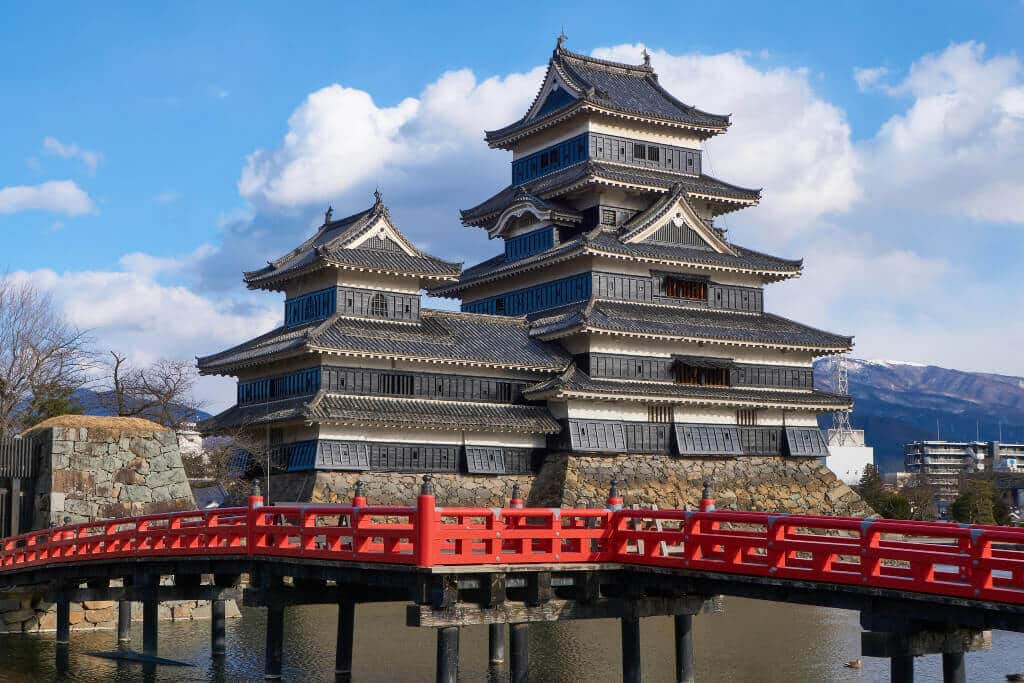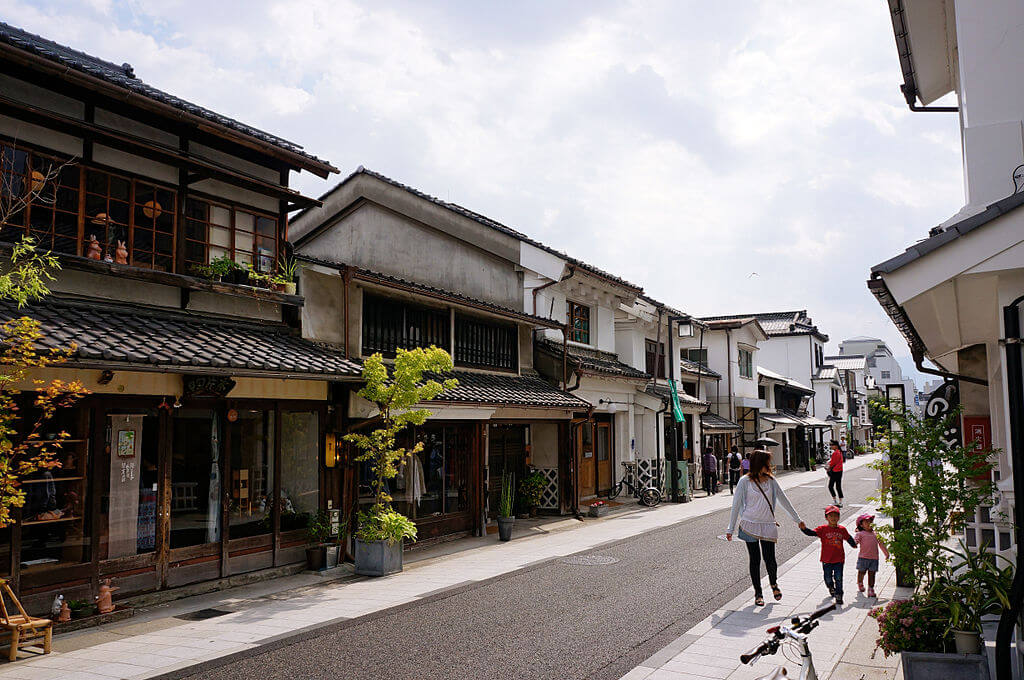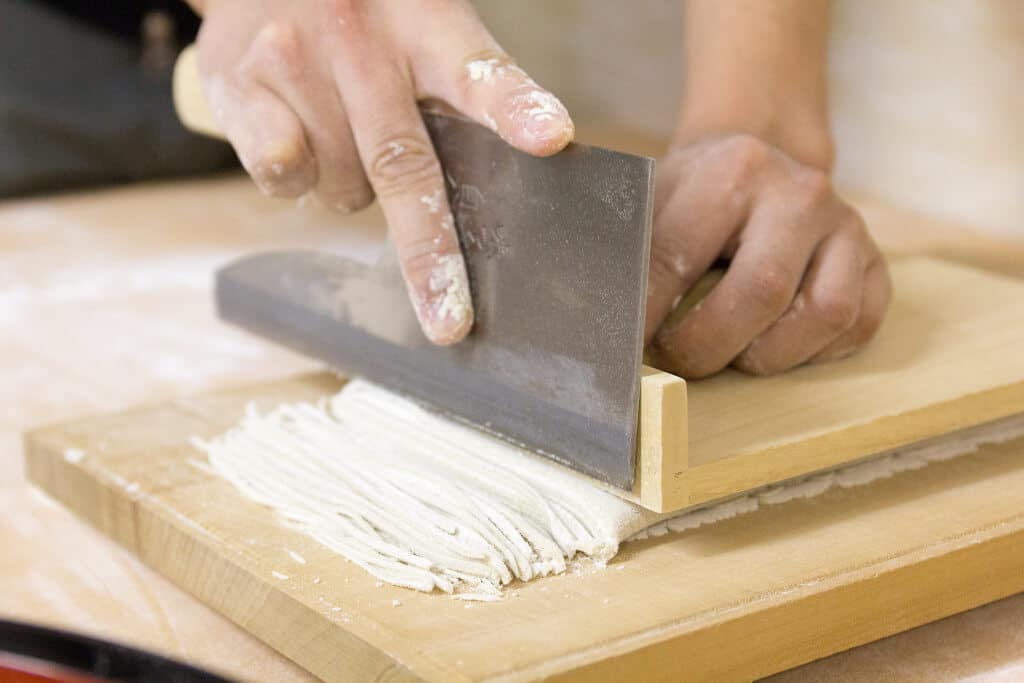I arrived in Matsumoto on a cold night, the chill of winter still enveloping the streets, a breath of rain in the air. The mountain cold was disorienting after having arrived from a distinctly warmer Tokyo, on a bus that seemed to trundle endlessly past dark stretches of countryside.
Then the morning came clear and fresh, and I walked to Matsumoto Station. The view from the huge glass windows of the west exit was that of the Alps, the snow-capped mountain range in the distance. In stark, wintry relief against a clear blue sky, it’s a sight that etches itself into the very ventricles of your heart.
It calls to mind Robert MacFarlane’s meditation on mountains, on how they, “like all wildernesses, challenge our complacent conviction — so easy to lapse into — that the world has been made for humans by humans.”
If you travel to Matsumoto, arrive in the morning and let this be the first sight you see out of the station gates.
Matsumoto is famous for its magnificent black castle, museums, and surrounding mountains. Though it is the second largest city in Nagano prefecture, the city center is a manageable size, with wide pavements and boulevards that make it perfect for exploring on foot or bicycle.
The city architecture also seems to have an elegant, old-fashioned charm. There are old buildings from all periods, and many businesses have kept much of the slightly antiquated shopfront signage with fonts from decades ago.
Most importantly, it is a small city with a big heart. The people are as warm as the mountains are cold. A lady struck up a conversation with us about an umbrella stand in front of her shop. Smiles seem that much warmer after the coldness of the metropolis.
All this makes the city feel wonderfully removed from the hectic pace of urban living, a pause button in the form of this charming place just a few hours from Tokyo.
Originally published in 2019, this article was updated and republished on Oct. 25, 2022.

Things to See and Do in Matsumoto
Matsumoto is a compact city, but it doesn’t lack for things to do. Whether you’re interested in castles, art, food, or shopping, there’s something for everyone here.
Visit the 16th-Century Matsumoto Castle
Matsumoto is famous for its 16th-century black castle. A designated National Treasure, I think of it as the visual yin to Himeji Castle’s yang. By day, it is striking; by night, downright dramatic when lit from below, reflected in the surrounding pond.
The grounds outside the castle are lush, with a notable grove of plum trees—perfect for a romantic date of sorts. With plenty of space to roam around, there’s always a chance of encountering a friendly puppy or two around the castle.
History buffs should not miss visiting Matsumoto-jo, and everyone should go for the view of the surrounding mountains from the top floor.
Hop Down to Nawate Street
This street is a hop, skip, and jump away from Matsumoto Castle. Also known as Frog Street, it is lined with souvenir shops, snack stands, a few cafes and restaurants, a cotton candy machine, and an antique shop with an assortment of bric-a-brac verging on junk.
As befits its nickname, there are plenty of frog-themed goods to be found. It’s a nice road to walk along on your way to the next destination.
Take in the Historic Buildings of Nakamachi Street
Literally meaning “center” and “town,” Nakamachi Street, unsurprisingly, was in the center of Matsumoto when it was a castle town.
Part of the historic district of Matsumoto, this street is lined with beautifully preserved old buildings that are now largely crafts and folk shops, restaurants, and an inn or two.
It feels remarkably well-curated—each shop seems to have something delightful to discover, whether it’s ceramics or local miso—and it’s a wonderful street to explore.
Particularly noteworthy are the kura or old warehouse-style buildings built in the wattle and daub style, typical of districts with a significant merchant presence. They are recognizable by their stylish and characteristic black-and-white “sea cucumber” plaster walls for fire prevention.
One example is the Kurassic-kan, with its slightly groan-inducing name (a pun on “kura” and “classic”). It had a former life as a sake brewery, and is now used for exhibitions and the like, even housing Japanese gardens. where you can enjoy seasonal flower viewing.
In what seems like mind-boggling but charming specificity, there’s also a museum dedicated entirely to antique scales (measuring equipment, not fish) of all kinds—for sorting silkworm cocoons by weight and sex, for instance.

See Yayoi Kusama’s Work at the City Museum of Art
If you have only one day in Matsumoto, make this the focal point of your visit. Yayoi Kusama was born in Matsumoto, so it is fitting that one of the largest museums dedicated to her work is located right here.
If you haven’t been able to score tickets to her museum in Tokyo—which is also a lovely experience, albeit one requiring more planning—just head down to Matsumoto and show up at the City Museum of Art. Here, you can just walk in and buy tickets on the day you arrive.
Matsumoto has not reached fanatic tourist heights yet, so queues last a few minutes at most, and it is wonderful to experience Kusama’s art without the usual metropolitan hordes.
I can’t tell you how great it is to simply take a seat in the “Love is Forever” room and allow yourself to be swallowed by the huge, psychedelic canvases lining the walls. Plus, you can take photos in this section!
Enjoy Woodblock Prints at the Japan Ukiyo-e Museum
This museum is home to one of the world’s largest private art collections, but the actual number of woodblock prints on display is on the lower side—though it’s rotated fairly regularly.
It’s still worth a trip for serious woodblock print aficionados. The Japan Ukiyo-e Museum is a little farther afield of the city center, just a short 10-minute taxi ride from Matsumoto Station.
Explore Matsumoto’s Many Independent Shops
Yes, it’s an umbrella term that doesn’t even begin to cover the number of delightful little establishments waiting for you to discover them. Small cafes, izakaya, restaurants, and galleries abound. You’ll spot a few bakeries.
There are numerous shops selling crafts, ceramics, lacquerware, art, watches, antiques, secondhand books, and more. Let your eyes and feet be your guide.
I personally loved Schrödinger’s Closet, not far from the Yayoi Kusama Museum. What I thought was going to be a random little clothes shop turned out to stock some seriously swag-worthy gear. They also stocked these fantastic little hand-painted brooches in the shape of human hearts by an immensely talented local high schooler.

Side Trips From Matsumoto
Matsumoto is a great place to base yourself for a few days before venturing into the surrounding Alps. Here are just a few suggestions.
Kamikochi
When the hiking season begins and warmer weather arrives, strap on your walking boots and head for the mountains of Kamikochi.
Kamikochi is a mountain resort in the Japanese Alps, and it’s one of the most pristine, gorgeous mountain areas in the country, with the kind of landscapes that make your breath catch in your throat. Lush forests, hiking trails, and spectacular views are plenty, as are onsen soaking opportunities.
It’s easily accessible from Matsumoto by a 90-minute bus ride. Visiting in a day is possible, but even better is to stay a few nights after a little time in Matsumoto, to explore the mountains. Perfect for hikers, bird-watchers, and nature lovers in general.
Norikura Kogen Highlands
This area is another fantastic destination for outdoorsy types. Summer sees excellent hiking conditions (check out all the waterfalls), while the Japanese winter is all about snowboarding and skiing. Or you could just soak in one of the onsen hot spring baths.
Hida Takayama
Usually known as Takayama, this little mountain town is a two-and-a-half hour bus journey from Matsumoto, so you’ll want to make it an overnight (or two-night) stay rather than a day trip.
Takayama is a favorite with travelers for the picturesque, old-world Edo-style architecture and small-town atmosphere, as well as the two major Japanese festivals in spring and autumn—the Sanno Matsuri and the Yahata Matsuri. Of course, meals centered around delicious local Hida beef is another reason to visit.
Don’t forget to visit the small but charming town of Hida Furukawa, just 15 minutes away from Takayama on the local train. It was the town that inspired Itomori, a fictional town in Makoto Shinkai’s blockbuster anime film Your Name. Fittingly, there have also been writing retreats held here.

Eating in Matsumoto
Nagano has no shortage of great food. Everyone will tell you it’s probably because of the mountains, and by extension, the delicious water. Whatever it is, there’s no denying that the food is spectacular.
Also, the cost-performance of eating out in Matsumoto—or cospa as we like to say in Japan—is fabulous. As a Tokyo dweller, I came to Matsumoto and cried over all the expensive lunches back in the Big Ume. It’s just a fact of small city living. The quality of cafe food in Matsumoto is uniformly high and priced far more competitively.
There’s way more bang for your buck here. Go before urban inflation catches up.
Soba
Buckwheat noodles are a Nagano speciality, so you are pretty much duty-bound to seek them out if you visit any town in this prefecture.
I find it hard to rave about soba joints in Tokyo because I’ve been so spoiled by small mountain town soba restaurants. The noodles here are just delicious—nutty, with that vital al dente bite to them. And once again, it’s all about the cospa.
You’ll want to look out for hachiwari or juwari soba, which refers to the ratio of buckwheat to wheat flour in the noodles.Hachiwari is a ratio of 8:2, whereas juwari is 100 percent buckwheat. The latter is the safest bet for people on gluten-free diets. But there’s no guarantee about the dipping sauce, so you’ll need to check if the soy sauce used contains any wheat.

Nozawana
You’ll see this leafy Japanese mustard green, which is great pickled or stewed, in restaurants, souvenir shops, and the rice balls in the local convenience shop.
Horse meat
Specifically, raw horse meat, or basashi. Don’t knock it until you try it. Raw slices of cold horse sashimi served with local soy sauce and a small pile of finely grated garlic ranks as one of the top most exquisite mouthfuls in the prefecture. Even better if you find it drizzled with a little nutty sesame oil.
Miso
Everywhere you turn, you’ll see Shinshu miso—a salty, earthy, umami-packed yellow paste made by fermenting rice, salt, and soybeans—being sold in Matsumoto.
Shinshu is the name for an old province that’s now modern-day Nagano prefecture, with its capital near what is today Matsumoto. With its cool weather, clean air, and fantastic local ingredients, the city has great conditions for aging miso. It’s no surprise that it produces such delicious miso.
Shinshu miso makes a great souvenir or gift for the chefs in your life. Miso soup is an obvious dish, but you could also use it as a marinade for fish, meat, or vegetables. Smear on rice balls before grilling; mix with chunks of crispy lard and broiled tomatoes for a funky, salty dip that’s out of this world.
Cheesecake
I’m not kidding. A shop called Komugi-ya sells some of the most phenomenal cheesecakes I’ve ever had. Think flavors like Parmesan and Camembert. Eat and weep tears of joy.
Planning Your Trip: When to Visit
Anytime.
It’s hard to find a bad time to visit Matsumoto, since each season has its own charm.
The best time to visit Japan is unique to every person. For some people, Matsuomo’s picturesque winters are ideal, while others prefer the spring cherry blossom season, or Matsumoto’s warm and pleasant summers.
Winter is great if you love winter sports—ski trips out to the nearby mountains will be a blast. Plum blossom season is lovely; cold but not winter-frigid, and you’ll still be able to enjoy the snow-capped mountains.
The hiking season is always a good time to visit. Spring is gloriously lush, and autumn turns the surrounding greenery into streaks of yellow and red.
Even summer is a good time to visit. There are festivals, and the mountains make Matsumoto far less humid and hot than it could otherwise be.

Getting Around the City
Central Matsumoto is quite compact, so most of the major areas can be covered in a day or two. Walking is the best way to discover the city.
Alternatively, hop on a bicycle. Some hostels and hotels have bicycles available for rental. If you want to explore the surrounding mountain towns, renting a car is also a good option.
Accommodations
Because it’s in the heart of the mountains, there’s no shortage of hot spring inns in Matsumoto. A favorite luxury option is KAI Matsumoto.
Located a 15-minute drive from Matsumoto Castle, guests will love the contemporary take on traditional ryokan rooms, outdoor baths with gorgeous mountain views, regional wine selections, and nightly concerts in the lobby.
A more budget-friendly option is Tabi Shiro, a charming local guesthouse in the city run by some super friendly folks. Bonus: You’ll snag a free drink ticket when you check in.
Final Thoughts on Matsumoto
If you’re looking for a Tokyo getaway, Matsumoto is a perfect choice—it’s sure to charm the first-time visitor. But it’s also a fantastic base for day trips out to Nagano or Gifu prefectures, and a great transition point for heading out into the Central Alps.
Cities like Matsumoto are often overlooked by first-time visitors to Japan in favor of destinations like Tokyo and Kyoto. But if you have more time to spare, and a taste for a slower pace of travel, you’ll love a city like Matsumoto. If you’re planning a holiday to Japan, why not make some time for a trip out to these parts?
Looking for More Authentic Japanese Experiences?
We believe your Japan itinerary should be a reflection of your personal sense of adventure and style, and that no two travelers (or trips!) are alike. If you are looking to embark on a once-in-a-lifetime trip to Japan, we have resources that can help.
Start by checking out our sample travel itineraries and learning about our process of crafting customized trips for travelers seeking unique, authentic experiences.


